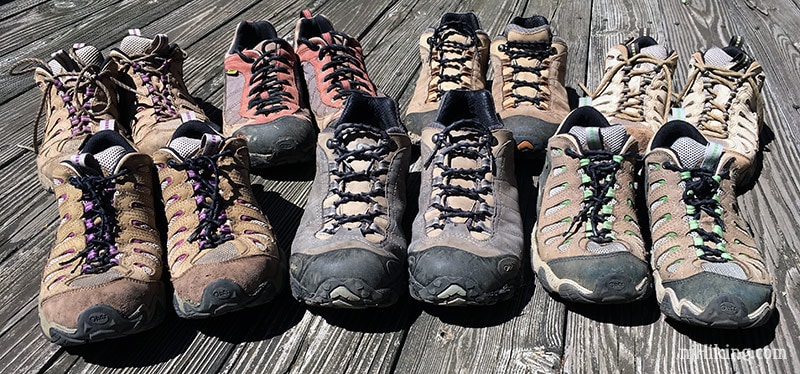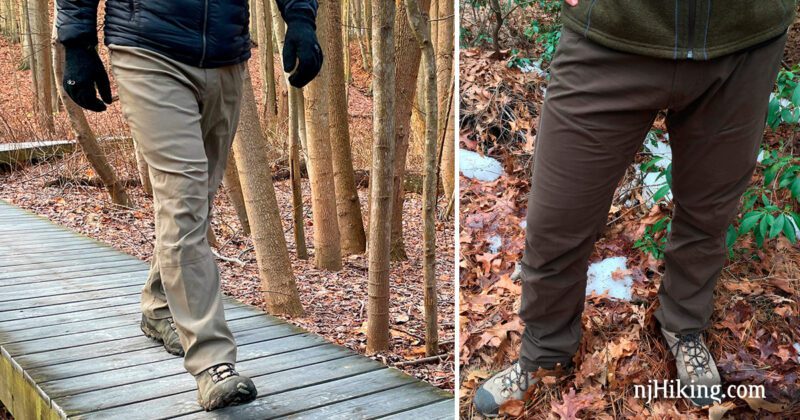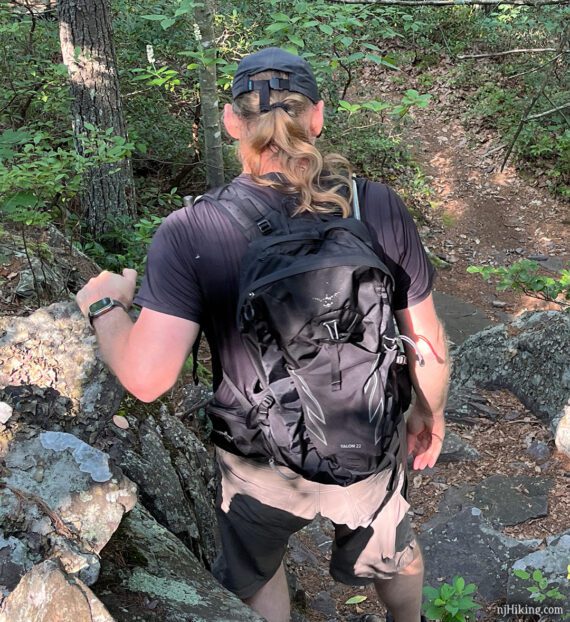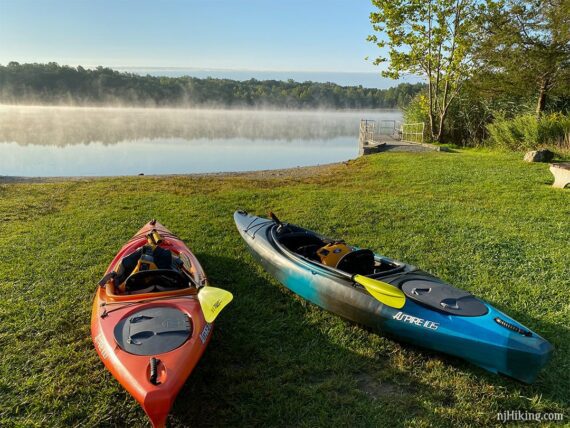Hiking requires little to get started, but proper clothing and gear can make a big difference in comfort.
We’ve been avid hikers for over 25 years – heading out on local trails every weekend, as well as hiking throughout the United States and internationally. We’ve used plenty of clothing and gear over the years and list some of our current favorites below, along with some buying tips.
Keep in mind that clothing and gear styles change constantly, and something may no longer be available or works/fits as we described.
This is the hiking footwear, clothing, and gear we personally use. We do an absurd amount of research before we buy anything and are very particular because our stuff gets a lot of use. A link to a full review is included if we’ve done one. All are our own purchases unless otherwise noted.
Favorite Hiking Footwear
This is a “brief” list of what footwear we’re using now. For more detailed reviews see our Hiking Footwear page.
- Women’s – Oboz Katabatic Low
- Women’s – Oboz Sawtooth Low
- Women’s – Oboz Bridger Mid
- Women’s – Keens Newport H2 water sandal
- Men’s – On Cloudwander
- Men’s – Oboz Bridger Mid
- Men’s – Keen Newport H2 water sandal

Related: Gifts for Hikers
Favorite Hiking Pants and Shorts
These are what we’re currently using. For more details see our Hiking Pants and Shorts page.
- Columbia Knee Pants (Women’s, 3-season)
- Kühl Klash Pant (Women’s, winter)
- Kühl Renegade Pant (Men’s; all around)
- Kühl Konfidant Air Pant (Men’s; lightweight/summer)
- Kühl Transcendr Pant (Men’s; winter)
- Kühl Radikl Short (Men’s)

See Also: Kuhl’s Renegade Pant | Kuhl’s Konfidant Air Pant | Kuhl’s Klash Pant | Kuhl’s Interceptr Jacket
Favorite Hiking Shirts and Layers
We’ve used lots of different top layers over the years but we keep them for so long they aren’t available anymore. For more details see our Hiking Shirts and Layers page. These are the most recent pieces:
- Smartwool Quarter Zip (Women’s)
- Patagonia Capilene Cool Daily Hoodie (Women’s)
- Kühl Interceptr Jacket (Men’s)

Favorite Hydration Backpacks
I’ve been using the ever-popular CamelBak M.U.L.E since 2014 and it’s still perfect for me. See our full CamelBak M.U.LE. review.

Tom replaced his trusty but 15-year-old Kelty with a Osprey Talon 22 in early 2022 and has been really happy with it. The Talon also does double-duty as his carry-on bag.

Favorite Water Bottle
We like the HydraPak Recon Water Bottle mainly due to the twist cap that allows the water to flow as if drinking from a glass. Lightweight, easy to clean, and offers multiple cap colors. Not insulated – we add ice if need it super cold (heavy metal insulated bottles are too heavy to bother with). After liking the 25 oz. that came in a Cairn Box, I got another for Tom and later got two 17 oz. bottles. These are for short hikes when we don’t use a hydration reservoir, as well as for travel, daily workout and at-the-desk bottles.

Favorite Trekking Poles
I’m currently using Black Diamond’s Alpine Carbon Cork poles (Women’s-specific version). I’m really happy with them – sturdy but super lightweight and comfortable. My prior pair was also Black Diamond. See our page on trekking poles for more detail.

Favorite Monocular / Binocular
I can’t count the many times I’ve used this to quickly make sure that the dark shadow down the trail is actually just a bear-shaped tree stump. We chose this model due to its balance of function, size, and price and have been using it since 2014. Read our full review of the Vortex Optics Solo Monocular.
In 2019 we decided to get an affordable not-too-fancy waterproof binocular that floats (and screaming yellow to be visible!) for when we kayak in New Jersey.

Favorite Buffs
This versatile tube of fabric can be easily configured into a hat, neckerchief, hairband, balaclava, and more. We’ve been using our Polar Buffs for years in winter. We also have lightweight and UV-protective Original Buffs for our summer adventures.

Favorite Winter Traction
Winter traction is like adding snow chains to your feet and totally increased our winter hiking when we started using them many years ago. We use MICROspikes for hiking and prefer YakTrax for light walking around and shoveling the driveway. Check out our comparison of Kahtoolas vs YakTrax.

Favorite Snowshoes
We use the MSR Women’s Lightning Axis 22 and the MSR Lightning Axis 25. While these exact models are no longer available the MSR Lightning Explore is the comparable model. These are a huge step up from our prior models. See our Snowshoe Guide for more detail on them, as well as our Snowshoeing in NJ page.

See Also: Winter Hiking | Traction Devices
Favorite Bikes
In 2021 we upgraded our rides to Priority 600s and now our biking is all fun and no fuss. We only bike rail-trails and we’d been using basic hybrid bikes since 2006 (and before that some random used bikes we’d gotten from a co-worker!). Those worked alright but we didn’t love them – or the upkeep.
NYC-based Priority Bicycles specializes in all-terrain / all-condition bikes with no routine maintenance, a Pinion gear box, and grease free Carbon Drive belt.
What all that means is they ride like butter with no more chunk-chunk-chunk-clank when shifting gears. We just chuck ’em on the Hikemobile and do a quick wash when they’re dirty. No worrying about maintenance. Our free time is for fun, not tinkering.
They even can deal with more than the dirt, gravel, and occasional pavement we got them for. Like that deeeeep mud once on the Paulinskill Valley Trail… or part of the Great Valley Trail that pushes the definition of “rail-trail”… or that one time we thought we could bike Minnewaska in N.Y. but the “carriage road” was more like a mountain bike trail (yowza).
Basically, these bikes can handle more than we can – and they even look cool!

Favorite Kayaks
We absolutely love love love our Wilderness Systems’ Aspire kayaks (the shorter Aspire 100 for me, 105 for Tom). They glide through the water, have fantastic handling, and are not overly long or heavy to pop them on top of the Hikemobile.
Our page on Buying a Kayak covers the process as well as what accessories we have, but it still has the models we started with as I haven’t updated with these much better yaks. Also check out our page on Kayaking in NJ for guides on where to go.

Hiking Clothing and Gear Shopping Tips
Learn to layer. This is a really key clothing concept for hiking. By layering clothing, temperature can be regulated just by adding or removing a piece.
- Base Layer – performance shirt (short or long-sleeved) next to your skin
- Insulation Layer – such as fleece shirt or jacket
- Protective Layer – wind/rain resistant shell
- Hat/Gloves – a lot of heat is lost through the head/hands
The goal is to stay comfortable, dry and avoid hypothermia. If you overheat, you’ll start sweating and your clothing becomes wet, putting you at risk. A performance, or “wicking”, shirt will pull the moisture away from your skin while with cotton you’ll stay wet.
Get a core set of clothing. These basic items will cover an average hiker year-round: One wicking tee, one wicking long sleeve tee, fleece layer, rain shell, hiking pants and shorts, footwear, socks, hat, gloves and perhaps a warmer layer for winter. You’ll only need multiple shirts, pants, and socks for hiking trips.
Quality pieces will last. We hike nearly every week and are using backpacks, pants, shirts, and jackets that range in age from a few to 10+.
See Also: Snowshoe Guide | Snowshoeing in New Jersey
Choose wisely. Since the gear can last and can be pricey – make sure you like it. We’ve kept using our backpacks and clothing not only because they last but because they are comfortable and useful. Take the time to research options and read reviews.
Invest in decent hiking footwear. This is the one key piece that is more important over everything else, regardless of how often you’ll hike.
Save money with store brands. The fit and quality of store brands is often as good as the big brands… but can cost less.
Work the clearance racks. Get more stuff that way! Last years styles and colors are your friend – the trail doesn’t care about fashion trends. Those with uncommon shoe sizes can really score here.
Buy off season. Try to plan purchases at end-of-season clearance sales. Try not to buy hiking shorts just as the weather warms up, buy new winter gloves at the end of winter, etc. I like to check 6-12 months after buying boots to see if I can scoop up the same pair on sale. They don’t go bad and I have one ready as soon as the current wears out.
Membership clubs. Some gear shops offer coupons to “members”, or offer year-end dividends on non-sale purchases.
Only hike occasionally or just trying it out? Then don’t break the bank on gear right away. Suitable basic items can be found at sports stores, and even big box stores have decent quality. Start with inexpensive workout gear for shirts and pants and replace it later with better versions if you start to hike more frequently.
Double-duty. We often justify purchases because they will get used in other ways. Hiking wicking shirts can double as weekly workout wear. Hiking pants or a fleece can make good travel clothing. Our backpacks are our carry-on bags when we fly. Use YakTrax for icy sidewalks. We’ve even worn our gaiters to shovel deep snow off the driveway.
Remember…
Gear Rule #1: If you really love how a piece of clothing or footwear fits, always buy another because they will discontinue or change the style! Guaranteed.
Gear Rule #2: The only thing better than new gear, is new gear ON SALE!